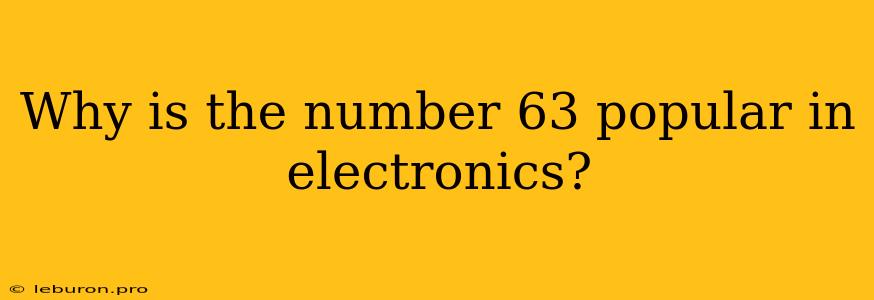The number 63 holds a unique significance in the realm of electronics, particularly in the context of digital circuits and data transmission. While it might seem like an arbitrary number at first glance, its popularity stems from its connection to the binary system, the fundamental language of computers. This article delves into the reasons behind the prominence of 63 in electronics, exploring its mathematical basis, practical applications, and the advantages it offers over other numerical choices.
The Binary Foundation: Understanding the Power of 2
To understand the significance of 63 in electronics, we must first grasp the underlying principles of the binary system. Unlike the decimal system (base 10), which uses ten digits (0-9), the binary system uses only two digits: 0 and 1. This system is ideal for representing electronic signals, where the presence or absence of an electrical current can be interpreted as a 1 or a 0.
The power of 2 plays a crucial role in binary numbers. Each position in a binary number represents a power of 2, starting from 2^0 (1) for the rightmost digit and increasing by one for each position to the left. For example, the binary number 1101 is equivalent to:
- 1 x 2^3 (8) + 1 x 2^2 (4) + 0 x 2^1 (0) + 1 x 2^0 (1) = 13 in decimal.
This binary representation allows for efficient encoding of data and instructions within digital circuits.
The Significance of 63: A Binary Powerhouse
The number 63 holds a special place in electronics due to its binary representation: 111111. This pattern of all '1's makes it a powerful number for various electronic applications:
1. Representing Maximum Values: In digital systems, a specific number of bits (binary digits) is often allocated to represent a particular range of values. When a binary number is used to represent a value, the maximum value that can be represented is one less than the next power of 2. For a 6-bit binary number, the maximum value is 2^6 - 1 = 63. This allows for a convenient way to represent the maximum value within a defined number of bits.
2. Efficient Division and Multiplication: Binary numbers are easily divisible by powers of 2. 63, being the maximum value for 6-bit numbers, is divisible by 3, 7, 9, and 21, all of which are relevant in digital signal processing and memory addressing. This divisibility simplifies calculations and reduces computational overhead in digital circuits.
3. Convenient for Addressing and Indexing: In computer memory and data storage, memory addresses and data indices are often represented using binary numbers. 63, as the maximum value for a 6-bit system, simplifies the addressing process by allowing for a direct mapping between binary addresses and memory locations.
Practical Applications of the Number 63 in Electronics
The versatility of 63 makes it a valuable tool in various electronic applications:
1. Digital Signal Processing (DSP): 63 plays a significant role in audio and video processing algorithms, particularly in signal filtering and modulation techniques. The number 63 often appears in coefficients used for filtering or transforming signals, exploiting its divisibility for efficient calculations.
2. Memory Addressing and Data Manipulation: 63's binary structure makes it a natural choice for representing memory locations and indices within microprocessors and memory controllers. The simplicity of its binary representation simplifies memory addressing operations and data manipulation.
3. Timers and Counters: 63 is frequently used in timer and counter circuits, allowing for a convenient way to count up to a specific number of cycles or events. In hardware designs, timers and counters are essential for tasks such as timing sequences, controlling intervals, and generating specific frequencies.
4. Bitwise Operations: In bitwise operations, which manipulate individual bits within a binary number, 63 provides a convenient "mask" for extracting or modifying specific bits. For example, a bitwise AND operation with 63 (111111) can extract the last six bits of a binary number.
Advantages of Using 63 in Electronics
The popularity of 63 in electronics stems from its distinct advantages:
1. Simplicity and Efficiency: The all-ones binary representation of 63 simplifies mathematical operations, leading to faster and more efficient computations in digital circuits.
2. Flexibility: 63's divisibility makes it adaptable to a wide range of applications, from signal processing to memory management. This flexibility allows designers to use it in various contexts without significant adjustments.
3. Standardization: The use of 63 is often standardized in hardware design, promoting interoperability and reducing design complexity. This standardization ensures consistency across different components and systems.
4. Ease of Implementation: The simplicity of 63 makes it easier to implement in hardware, reducing the complexity of circuits and lowering design costs.
Conclusion: Why 63 Reigns Supreme in Electronics
The number 63, seemingly a simple integer, holds a significant position in the world of electronics. Its binary representation, its divisibility properties, and its inherent power in representing maximum values make it an indispensable tool for digital circuits and data manipulation. From signal processing to memory management, 63's versatility and efficiency make it a fundamental constant in the language of electronics. Its significance extends far beyond its numerical value, showcasing the profound relationship between mathematics and the world of electrical engineering.
